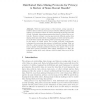10 search results - page 2 / 2 » On the Power of Two-Party Quantum Cryptography |
STOC
2002
ACM
14 years 5 months ago
2002
ACM
Secure multi-party computing, also called secure function evaluation, has been extensively studied in classical cryptography. We consider the extension of this task to computation...
APPROX
2004
Springer
13 years 10 months ago
2004
Springer
A quantum encryption scheme (also called private quantum channel, or state randomization protocol) is a one-time pad for quantum messages. If two parties share a classical random s...
EUROCRYPT
1990
Springer
13 years 9 months ago
1990
Springer
We describe results from an apparatus and protocol designed to implement quantum key distribution, by which two users, who share no secret information initially: 1) exchange a ran...
MADNES
2005
Springer
13 years 10 months ago
2005
Springer
With the rapid advance of the Internet, a large amount of sensitive data is collected, stored, and processed by different parties. Data mining is a powerful tool that can extract ...
TCC
2009
Springer
14 years 5 months ago
2009
Springer
It is well known that general secure function evaluation (SFE) with information-theoretical (IT) security is infeasible in presence of a corrupted majority in the standard model. ...

